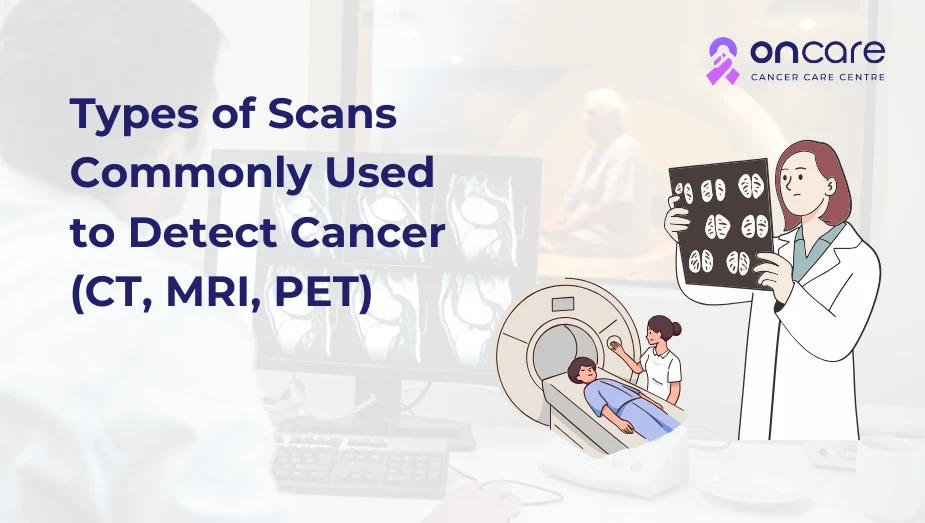Table of Contents
Types of Scans Commonly Used to Detect Cancer (CT, MRI, PET)

Cancer is a complex and life-threatening disease that often comes with a need for urgency. When it comes to surviving cancer, early diagnosis and timely, effective treatments make all the difference. But if you are concerned with how doctors spot complex diseases like cancer, often before symptoms appear, here’s the answer: it lies in powerful imaging technologies that give a chance of not missing out!
In this blog, we’ll discover more about how these three major imaging techniques work and which one is best at detecting cancer. This guide will help you understand its role in imaging in modern medicine.
CT Scan
A CT scan often combines X-ray images that are usually taken from different angles. It generally uses a computer to create more detailed cross-sectional images of the patient’s body. In this scan, it generally shows bones, organs, and soft tissues in high clarity.
Uses
- CT scan generally performed to detect tumors or abnormal growths
- To analyze the size, shape, and location of a tumor
- To check whether the cancer has spread to any organs or distant organs in the body
- To guide biopsy removing tissue for testing
Advantages of performing CT Scan
Here are some of the advantages of performing CT scans.
These may include:
- These tests are fast and widely available in India.
- These are excellent for diagnosing cancer in the lungs, liver, bones, and blood vessels.
- These tests are highly precise for detecting cancers in the chest, abdomen, and pelvis.
Key characteristics
Here are some accurate characteristics of CT scan.
These may include:
- Performing these scans involves exposure to low levels of radiation
- A healthcare professional often requires contrast dye, which can cause allergic reactions in rare cases.
MRI Scan
MRI (magnetic resonance imaging) tests use strong magnetic fields and radio waves (not radiation) to create detailed images of the inside of the body. It’s especially effective at visualizing soft issues. Performing these scans is especially useful at visualizing soft tissues like muscles, ligaments, and organs.
Uses
- The scans are used to detect tumors in the brain, spinal cord, prostate, and other soft tissues.
- These are useful to differentiate between benign and malignant tumors.
- Doctors used to provide highly detailed images before surgery or radiation therapy.
Advantages of MRI Scan
Here are some accurate advantages of MRI Scan, these may include:
- There is no exposure to ionizing radiation
- Performing these scans are excellent for imaging the brain, muscles, connective tissues, and organs
- It offers more detailed information than CT scan in some areas of the body
Key characteristics
Here are some key characteristics of MRI Scan, these may include:
- The process can typically take between 30 and 90 minutes, slower than a CT scan.
- This process is not suitable for patients with metal implants or other implants in their body.
- The process can appear noisy and cause discomfort in people with claustrophobia.
PET Scan
Performing PET scans involves injecting a small amount of radioactive material into the body. Since cancer cells grow rapidly and consume more sugar than normal cells, this type of scan highlights the areas of high activity.
Uses:
To detect the cancer that has spread (metastasized)
- These tests are used to evaluate whether the treatment is working in the patients or not.
- It is used to find cancer that may not be visible on CT or MRI scans.
- It is often combined with a CT scan, including a PET/CT scan, for more accurate results.
Advantages
Here are some accurate advantages of PET scan, these may include:
- Performing these scans often shows the metabolic activity, not just structure
- It can detect even small and hidden tumors in the body
- It helps to monitor the treatment effectiveness in patients
Key characteristics
Here are some key characteristics of PET Scan, these may include:
- It involves the exposure to radioactive material (though in small amounts).
- Not as effective for tumors in low-metabolism areas (brain or kidney tumors)
The importance of choosing the right scan for cancer diagnosis
Cancer specialists often choose the imaging technique based on these factors. These may include:
- The type of cancer and its growth in a suspected cancer patients
- The location in the body
- The goal of the scan (diagnosis, staging, treatment and monitoring)
In some cases, performing several scans and tests are used together to get the most complete picture.
For example, performing a PET/CT scan combines both functional and structural images of the suspected patients. It offers various purposes while performing these scans and tests in a single session.
How Oncare choose the right scan for you
At Oncare, our oncologists and radiologists personalise every imaging test based on the patient’s symptoms, overall medical and health condition and previous health history. In most cases, performing a CT scan is the first step, especially when the doctor needs a quick and broad view of the suspected patient’s body.
If the oncologist needs more details and information, then they may recommend performing an MRI. In some cases, performing a CT scan often reveals some suspicions that enable you to undergo an MRI for close examinations.
If you have any concerns about any of these imaging techniques and scans, then visit Oncare Cancer Center and book an appointment with our experienced cancer specialist. Our team will work with you to find the safest, most comfortable, and most suitable solution for your concerns.
Consult Today
Cancer care and its diagnosis have come a long way because of the growth and expansion of modern medical science, especially the cancer sector. It includes CT scans, MRIs, and PET scans, each offering unique insights that help cancer specialists detect cancer early, plan several treatments effectively, and track progress over time.
At Oncare, we offer premium-quality cancer treatments including advanced cancer surgeries at affordable cancer treatments with an experienced cancer specialist consultation.
If you or any loved ones of yours are diagnosed with cancer, then visit Oncare’s cancer center and book an appointment with our cancer specialist today. Get an estimated cost of your cancer treatments today!
Frequently Asked Questions
A CT Scan is used to diagnose cancer often used for X-rays and a computer to create detailed pictures of the body. This is used to identify several tumors, its size, shapes and location. In some cases, a type of abdominal CT scans can be performed to detect bladder, bowel, kidney, ovarian, and stomach cancers in suspected patients.
MRI is used to perform on suspected cancer patients. It is used to help doctors to find cancer in their patient's body. It is used to check for the signs that cancer has spread.
CT scans are used to detect cancers from different angles to show images of the patient’s body organs, tissues, and bones. While the PET scan shows how the suspected patient’s cells are reacting to a radiotracer, that may indicate cancerous areas.
An healthcare professional might provide an Order a PET scan to check for signs of:
- Cancer, including breast cancer, lung cancer and thyroid cancer
- Coronary artery disease, heart attack or other heart-related issues
- Brain conditions such as brain tumors, epilepsy, dementia, and Alzheimer's disease.

